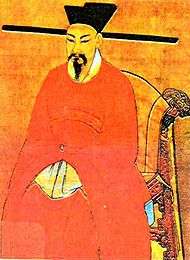Mongol conquest of the Song dynasty
| Mongol conquest of the Song dynasty | |||||||||
|---|---|---|---|---|---|---|---|---|---|
| Part of Mongol invasion of China and Kublai Khan's Campaigns | |||||||||
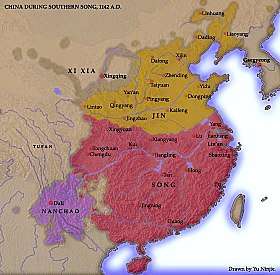 Southern Song before Mongol World conquests, areas of Xia and Jin dynasties were controlled by the Mongols in 1228. | |||||||||
| |||||||||
| Belligerents | |||||||||
| Yuan dynasty | Southern Song dynasty | ||||||||
| Commanders and leaders | |||||||||
|
Ögedei Tsagaan Khochu Töregene Güyük Khan Möngke Khan (possibly †) Kublai Bayan Aju Arikhgiya Shi Tianze[1] Zhang Hongfan Zhang Rou Guo Kan |
Emperor Lizong of Song Emperor Duzong of Song Emperor Gong of Song Emperor Duanzong of Song Emperor Bing of Song † Jia Sidao Lü Wenhuan Li Tingzhi Zhang Shijie Wen Tianxiang | ||||||||
| Strength | |||||||||
| More than 450,000 (including the Mongols, the Khitan, the Jurchens, the Han Chinese, the Alans, the Turkics, Central Asians) | unknown | ||||||||
| Casualties and losses | |||||||||
| Very heavy | Very heavy | ||||||||
The Mongol conquest of the Song dynasty under Kublai Khan (r. 1260–1294) was the final step for the Mongols to rule the whole of China under the Yuan dynasty. It is also considered the Mongol Empire's last great military achievement.[2]
Background
Before the Mongol–Jin War escalated, an envoy from the Song dynasty arrived at the court of the Mongols, perhaps to negotiate a united offensive against the Jin dynasty, who the Song had previously fought during the Jin–Song Wars. Although Genghis Khan refused, on his death in 1227 he bequeathed a plan to attack the Jin capital by passing through Song territory. Subsequently, a Mongol ambassador was killed by the Song governor in uncertain circumstances.[3] Before receiving any explanation, the Mongols marched through Song territory to enter the Jin's redoubt in Henan. In 1233 the Song dynasty finally became an ally of the Mongols, who agreed to share territories south of the Yellow River with the Song. Song general Meng Gong defeated the Jin general Wu Xian and directed his troops to besiege the city of Caizhou, to which the last emperor of the Jurchen had fled. With the help of the Mongols, the Song armies were finally able to extinguish the Jin dynasty that had occupied northern China for more than a century. A year later, the Song generals fielded their armies to occupy the old capitals of the Song, but they were completely repelled by the Mongol garrisons under Tachir, a descendant of Boorchu, who was a famed companion of Genghis Khan. Thus the Mongol troops, headed by sons of the Ögedei Khan, started their slow but steady invasion of the south. The Song forces resisted fiercely, which resulted in a prolonged set of campaigns; however, the primary obstacles to the prosecution of their campaigns was unfamiliar terrain that was inhospitable to their horses, new diseases, and the need to wage naval battles, a form of warfare completely alien to the masters of the steppe. This combination resulted in one of the most difficult and prolonged wars of the Mongol conquests.[4] The Chinese offered the fiercest resistance among all the Mongols fought, the Mongols required every single advantage they could gain and "every military artifice known at that time" in order to win.[5] A greater amount of "stubborn resistance" was put up by Korea and Song China towards the Mongol invasions than the others in Eurasia who were swiftly crushed by the Mongols at a lightning pace.[6]
The Mongol force which invaded southern China was far greater than the force they sent to invade the Middle East in 1256.[7]
Han defectors
Many Han Chinese defected to the Mongols to fight against the Jin. Two Han Chinese leaders, Shi Tianze, Liu Heima (劉黑馬, Liu Ni),[8] and the Khitan Xiao Zhala (蕭札剌) defected and commanded three Tumens in the Mongol army.[9] Liu Heima and Shi Tianze served Ogödei Khan.[10] Liu Heima and Shi Tianxiang led armies against Western Xia for the Mongols.[11] There were 4 Han Tumens, with each Tumen consisting of 10,000 troops. The four Han Generals Zhang Rou, Yan Shi, Shi Tianze, and Liu Heima commanded the four Han tumens under Ogödei Khan.[12][13][14][15]
Shi Tianze was a Han Chinese who lived in the Jin dynasty (1115–1234). Interethnic marriage between Han and Jurchen became common at this time. His father was Shi Bingzhi (史秉直, Shih Ping-chih). Shi Bingzhi was married to a Jurchen woman (surname Na-ho) and a Han Chinese woman (surname Chang), it is unknown which of them was Shi Tianze's mother.[16] Shi Tianze was married to two Jurchen women, a Han Chinese woman, and a Korean woman, and his son Shi Gang was born to one of his Jurchen wives.[17] His Jurchen wive's surnames were Mo-nien and Na-ho, his Korean wife's surname was Li, and his Han Chinese wife's surname was Shi.[16] Shi Tianze defected to the Mongol Empire's forces upon their invasion of the Jin dynasty. His son Shi Gang married a Kerait woman, the Kerait were Mongolified Turkic people and considered as part of the "Mongol nation".[18][19] Shi Tianze (Shih T'ien-tse), Zhang Rou (Chang Jou, 張柔), and Yan Shi (Yen Shih, 嚴實) and other high ranking Chinese who served in the Jin dynasty and defected to the Mongols helped build the structure for the administration of the new state.[20] Chagaan (Tsagaan) and Zhang Rou jointly launched an attack on the Song dynasty ordered by Töregene Khatun.
The Yuan dynasty created a "Han Army" (漢軍) out of defected Jin troops and an army of defected Song troops called the "Newly Submitted Army" (新附軍).[21]
The 1227 incident
In the early spring of 1227, Genghis Khan ordered a small fraction of the army to advance into Song's Circuit of Lizhou (利州路), in the name of attacking Jīn and W. Xia. The five zhous of Jie(階), Feng (鳳), Cheng(成), He (和) and Tianshui(天水)were ravaged. Then the Mongols moved southward and seized Wénzhou(文州). In July, the Mongols returned to the north. Genghis Khan further realized that to destroy the Jīn dynasty the Mongol army must make its way via the Song. The 1227 incident(丁亥之變) was the first armed conflict between the Mongols and the Song. But until this time the main target of the Mongols was Jīn dynasty.[22]
Battles of Shukou
From the winter of 1230 to the autumn of 1231, the Mongols forcibly passed through the Song dynasty. In the region centered on the three passes of Shukou(蜀口), they entered into a series of battles with the Song army. This was the second and largest armed conflict between them before the Mongol conquest of Song officially began.[23]
First stage (1235–48)
From 1235 on, the Mongol general Kuoduan Hequ started to attack the region of Sichuan through the Chengdu plain. The occupation of this region had often been an important step for the conquest of the south. The important city of Xiangyang, the gateway to the Yangtze plain, which was defended by the Song general Cao Youwen, capitulated in 1236.[24] In the east, meanwhile, Song generals like Meng Gong and Du Guo withstood the pressure of the Mongol armies under Kouwen Buhua because the main Mongol forces were at that time moving towards Europe. In Sichuan, governor Yu Jie adopted the plan of the brothers Ran Jin and Ran Pu to fortify important locations in mountainous areas, like Diaoyucheng (modern Hechuan/Sichuan). From this point, Yu Jie was able to hold Sichuan for a further ten years. In 1239, General Meng defeated the Mongols and retook Xiangyang, contesting Sichuan against the Mongols for years.[25] The only permanent gain was Chengdu for the Mongols in 1241. In the Huai River area, the Mongol Empire's commanders remained on the defensive, taking few major Song cities, although Töregene and Güyük Khan ordered their generals to attack the Song.[26]
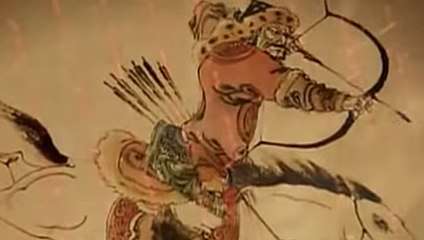
The conflicts between the Mongols and the Song troops took place in the area of Chengdu. When Töregene sent her envoys to negotiate peace, the Song imprisoned them.[27] The Mongols captured Hangzhou and invaded Sichuan in 1242. Their commanders ordered Zhang Rou and Chagaan (Tsagaan) to attack the Song. When they pillaged Song territory, the Song court sent a delegation to negotiate a ceasefire. Chagaan and Zhang Rou returned north after the Mongols accepted the terms.[28]
An account of the Mongol attack on Nanjing was given in a Chinese annal, describing the Chinese defenders use of gunpowder against the Mongols:
"As the Mongols had dug themselves pits under the earth where they were sheltered from missiles, we decided to bind with iron the machines called chen-t'ien-lei [thunder-shaking-the-sky]. . . and lowered them into the places",[29]
where the translation of the term for the device is that of Prof. Partington, who describes it as an iron pot filled with [huo] yao, literally "fire drug", a low-nitrate gunpowder or proto-gunpowder, sometimes lowered on chains, that sent forth "fire… out of every part," with an incendiary effect over many yards that could pierce metal to which it was attached, producing a "noise like thunder" that could be heard for miles, with the result that "the men and the oxhides were all broken into fragments (chieh sui) flying in all directions".[30][31]
Second stage (1251–60)
The Mongol attacks on Southern Song China intensified with the election of Möngke as Great Khan in 1251. Passing through the Chengdu Plain in Sichuan, the Mongols conquered the Kingdom of Dali in modern Yunnan in 1253. Möngke's brother Kublai and general Uriyangqadai pacified Yunnan and Tibet and invaded the Trần dynasty in Vietnam. The Mongols besieged Ho-chiou and lifted the siege very soon in 1254.
In October 1257 Möngke set out for South China and fixed his camps near the Liu-pan mountains in May. He entered Sichuan in 1258 with two-thirds of the Mongol strength. In 1259 Möngke died of cholera or dysentery during the battle of Diaoyucheng that was defended by Wang Jian.
The central government of the Southern Song meanwhile was unable to cope with the challenge of the Mongols and new peasant uprisings in the region of modern Fujian led by Yan Mengbiao and Hunan. The court of Emperor Lizong was dominated by consort clans, Yan and Jia, and the eunuchs Dong Songchen and Lu Yunsheng. In 1260 Jia Sidao became chancellor who took control over the new emperor Zhao Qi (posthumous title Song Duzong) and expelled his opponents like Wen Tianxiang and Li Fu. Because the financial revenue of the late Southern Song state was very low, Jia Sidao tried to reform the regulations for the merchandise of lands with his state field law.
Gunpowder weapons like the t'u huo ch'iang were deployed by the Chinese against the Mongol forces, which fired bullets from bamboo tubes.[32]
Prelude, and surrender of the Song dynasty (1260–1276)
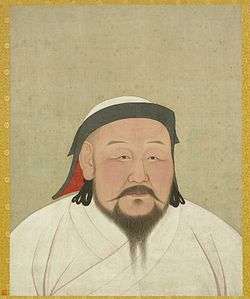
After Kublai was elected Great Khan of the Mongols in 1260 he was eventually able to conquer the Song to the south, but at great cost. From 1260 to 1264, he faced civil insurrection within the Mongol side led by his younger brother, Ariq Böke, who had been left in command of the north and stationed at the Mongol capital, Karakorum. This led to the Toluid Civil War and was followed by a major confrontation at the Diaoyu Fortress in Sichuan in 1265. The Mongols eventually defeated the Song land and naval armies and captured more than 100 ships.[33]
In 1268, the Mongol advance was halted at the city of Xiangyang, situated on the Han River, which controlled access to the Yangtze, the gateway to the important trading centre of Hangzhou.[34] The walls of Xiangyang were approximately 6 to 7 metres (20 to 23 ft) thick and encompassed an area 5 kilometres (3.1 mi) wide. The main entrances in the wall led out to a waterway impossible to ford in the summer, and impassable as a swamp and a series of ponds and mud flats in the winter. Xiangyang was linked to its twin city, Fencheng, on the opposite riverbank, by a pontoon bridge spanning the river from where the defenders of the twin settlements attempted to break the siege. However, the Mongols under Aju thwarted every attempt and crushed all reinforcements from the Song, each detachment numbering in the thousands.[35] According to Professor Zhang Lianggao of Huazhong University of Science and Technology, in 1269 (咸淳五年), the Mongols invaded the Yangtze River valley but were repulsed.[36] The Wuying Pagoda was rebuilt in 1270 (咸淳六年) in the throes of the overthrow of the Southern Song during the reign of Emperor Duzong.[37]
After this defeat, Aju asked Kublai for the powerful siege machines of the Ilkhanate. Ismail and Al-aud-Din, from Mosul, Iraq, arrived in South China to construct a new type of counterweight-driven trebuchet that could use explosive shells. The Mosuli engineers built the new siege trebuchets, and smaller mangonels,[38] and traction trebuchets as well. The design of the critical new counterweight trebuchets were taken from those used by Hulagu to batter down the walls of Baghdad in 1258. The counterweight trebuchets Hulegu used (referred to as "Frankish mangonels" in an official Ilkhanate history) were almost certainly borrowed from his Crusader state vassals, having been sent to the Levant by German and French crusaders by 1242 at the latest. According to the Ilkhanate historian Rashid Al-Din, the introduction of these weapons in 1268 was decisive and allowed the Mongols to rapidly conquer fortified cities they had previously deemed untakeable.[39][40]
Explosive shells had been in use in China for centuries, but the counterweight system of the trebuchet (as opposed to the torsion-type) gave greater range and accuracy while also making it easier to judge the force generated (versus by the torsion from repeated windings).[41] As such, the counterweight trebuchet built by the Persians were, practically speaking, greater in range,[42] and so could assist in destroying the walls at Fancheng with greater safety to the Mongol forces. The Muslim and additional Chinese engineers operated the artillery and siege engines for the Mongol armies.[43] Hence, the Chinese, who were the first to invent the traction trebuchet, now faced Persian-designed counterweight trebuchets on the side of the Mongol army, so by 1273 the Chinese were led to build their own counterweight trebuchets; as an account states, "In 1273 the frontier cities had all fallen. But Muslim trebuchets were constructed with new and ingenious improvements, and different kinds became available, far better than those used before."[44]
During the siege, both the Mongol and Song forces used thunder crash bombs, a type of incendiary gunpowder weapon of cast iron, filled with gunpowder. Each was delivered via trebuchet or by other means. The effects of these shells on men and natural materials was devastating, the noise destructive and resounding for many miles while iron armor could be penetrated by the bomb's casing during the explosion.[31] The Mongols also utilized siege crossbows, and the Song used fire arrows and fire lances as well.
Political infighting in the Song also contributed to the fall of Xiangyang and Fancheng, due to the power of the Lu family. Many questioned their allegiance to the Song, and the Emperor barred Jia Sidao himself from the command. Li Tingzhi, an enemy of the Lu family, was appointed commander. Jia permitted the Lu to ignore Li's orders, resulting in a fractious command. Li was then unable to relieve Xiangyang and Fancheng, managing only temporary resupply during several breaks in the siege.[45]
Bayan of the Baarin, the Mongol commander, then sent half of his force up-river to wade to the south bank in order to build a bridge across to take the Yang lo fortress; three thousand Song boats came up the Han river and were repulsed, with fifty boats destroyed and 2,000 dead. In the maritime engagements, the Song forces used paddle ships,[46] and on some ships at least, fire lance, siege crossbows, and incendiary devices were deployed against Mongol forces.[44]
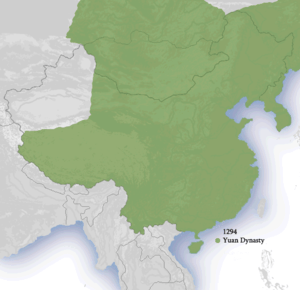
Xiangyang's commander then surrendered to the Mongol commander. The entire force, now including the yielding commander, sailed down the Yangtze, and the forts along the way fell, as this commander, now allied with the Mongols, had also commanded many of the down-river garrisons. In 1270, Kublai ordered the construction of five thousand ships. Three years later, an additional two thousand ships were ordered built; these would carry about 50,000 troops to give battle to the Song. In 1273, Fancheng capitulated, the Mongols putting the entire population to the sword to terrorize the inhabitants of Xiangyang. After the surrender of the city of Xiangyang, several thousand ships were deployed. The Song fleet, despite their deployment as a coastal defense fleet or coast guard more than an operational navy, was more than a match for the Mongols. Under his great general Bayan, Khublai unleashed a riverine attack upon the defended city of Xiangyang on the Han River. The Mongols prevailed, ultimately, but it would take five more years of hard combat to do so.[47]
Kublai had founded the Yuan dynasty in 1271, and by 1273, the Mongols had emerged victorious on the Han River. The Yangtse River was opened for a large fleet that could conquer the Southern Song empire. A year later, the child-prince Zhao Xian was made emperor. Resistance continued, resulting in Bayan's massacre of the inhabitants of Changzhou in 1275 and mass suicide of the defenders at Changsha in January 1276. When the Yuan Mongol-Chinese troops and fleet advanced and one prefecture after the other submitted to the Yuan, Jia Sidao offered his own submission, but the Yuan chancellor Bayan refused. The last contingents of the Song empire were heavily defeated, the old city of Jiankang (Jiangsu) fell, and Jia Sidao was killed. The capital of Song, Lin'an (Hangzhou), was defended by Wen Tianxiang and Zhang Shijie. When Bayan and Dong Wenbing camped outside Lin'an in February 1276, the Song Grand Empress Dowager Xie and Empress Dowager Quan surrendered the underage Emperor Gong of Song along with the imperial seal. Emperor Gong abdicated, but faithful loyalists like Zhang Jue, Wen Tianxiang, Zhang Shijie and Lu Xiufu successively enthroned the emperor's younger brothers Zhao Shi and Zhao Bing. Zhao Shi was enthroned as Emperor Duanzong of Song far from the capital in the region of Fuzhou but he died soon afterwards on the flight southwards into modern Guangdong. Zhao Bing was enthroned as Emperor Huaizong of Song on Lantau Island, Hong Kong. On March 19, 1279 the Mongols defeated the last of the Song forces at the naval Battle of Yamen. After the battle, as a last defiant act against the invaders, Lu Xiufu embraced the eight-year-old emperor and the pair leapt to their deaths from Mount Ya, thus marking the extinction of the Southern Song.
Last stand of the Song loyalists (1276–79)
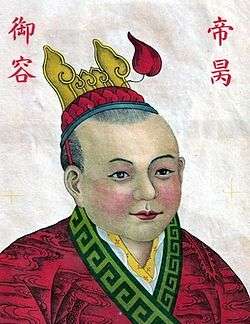
Empress Dowager Xie had secretly sent the child emperor's two brothers to Fuzhou. The strongholds of the Song loyalists fell one by one: Yangzhou in 1276, Chongqing in 1277 and Hezhou in 1279. The loyalists fought the Mongols in the mountainous Fujian–Guangdong–Jiangxi borderland. In February 1279, Wen Tianxiang, one of the Song loyalists, was captured and executed at the Yuan capital Khanbaliq (Dadu, modern Beijing).
The end of the Mongol-Song war occurred on 19 March 1279, when 1000 Song warships faced a fleet of 300 to 700 Yuan Mongol warships at Yamen. The Yuan fleet was commanded by Zhang Hongfan (1238–1280), a northern Chinese, and Li Heng (1236–1285), a Tangut. Catapults as a weapon system were rejected by Kublai's court, for they feared the Song fleet would break out if they used such weapons. Instead, they developed a plan for a maritime siege, in order to starve the Song into submission.
But at the outset, there was a defect in the Song tactics that would later be exploited by Yuan at the conclusion of the battle. The Song wanted a stronger defensive position, and the Song fleet "roped itself together in a solid mass[,]" in an attempt to create a nautical skirmish line. Results were disastrous for the Song: they could neither attack nor maneuver. Escape was also impossible, for the Song warships lacked any nearby base. On 12 March, a number of Song combatants defected to the Mongol side. On 13 March, a Song squadron attacked some of the Mongols' northern patrol boats. If this action was an attempted breakout, it failed. By 17 March, Li Heng and Zhang Hongfan opted for a decisive battle. Four Mongol fleets moved against the Song: Li Heng attacked from the north and northwest; Zhang would proceed from the southwest; the last two fleets attacked from the south and west. Weather favored the Mongols that morning. Heavy fog and rain obscured the approach of Li Heng's dawn attack. The movement of the tide and the southwestern similarly benefited the movement of the Mongol fleet which, in short order, appeared to the north of the Song. It was an unusual attack in that the Mongol fleet engaged the Song fleet stern first.
Prior to the battle, the Mongols constructed archery platforms for their marines. The position enabled the archers to direct a higher, more concentrated rate of missile fire against the enemy. Fire teams of seven or eight archers manned these platforms, and they proved devastatingly effective as the battle commenced at close quarter.
Li Heng's first attack cut the Song rope that held the Chinese fleet together. Fighting raged in close quarters combat. Before midday, the Song lost three of their ships to the Mongols. By forenoon, Li's ships broke through the Song's outer line, and two other Mongol squadrons destroyed the Song formation in the northwest corner. Around this time, the tide shifted; Li's ships drifted to the opposite direction, the north.
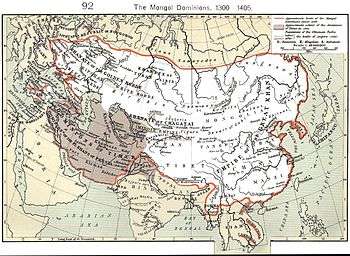
The Song believed that the Mongols were halting the attack and dropped their guard. Zhang Hongfan's fleet, riding the northern current, then attacked the Song ships. Zhang was determined to capture the Song admiral, Zuo Tai. The Yuan flagship was protected by shields to negate the Song missile fire. Later, when Zhang captured the Song flagship, his own vessel was riddled with arrows. Li Heng's fleet also returned to the battle. By late afternoon, the battle was over, and the last of the Song navy surrendered.
The ruling elite were unwilling to submit to Yuan rule, and opted for death by suicide. The Song councilor, who had been tasked with holding the infant child-emperor of the Song in his arms during the battle, also elected to join the Song leaders in death. It is uncertain whether he or others decided that the infant Emperor should die as well. The councilor therefore jumped into the sea, still holding the child in his arms. Tens of thousands of Song officials and women threw themselves into the sea and drowned. The last Song emperor died with his entourage, held in the arms of his councilor. With his death, the final remnants of the Song resistance were eliminated. The victory of this naval campaign marked the completion of Kublai's conquest of China, and the onset of the consolidated Mongol Yuan dynasty.
Members of the Song Imperial Family continued to live in the Yuan dynasty like Emperor Gong of Song, Zhao Mengfu, and Zhao Yong. Zhao Mengfu painted at the Yuan court and was personally interviewed by Kublai Khan. This practice was referred to as 二王三恪.
Chinese resistance in Vietnam against the Mongols
The ancestors of the Trần clan originated from the province of Fujian and later migrated to Đại Việt under Trần Kinh 陳京 (Chén Jīng), the ancestor of the Trần clan. Their descendants, the later rulers of Đại Việt who were of mixed-blooded descent later established the Tran dynasty, which ruled Vietnam (Đại Việt); despite many intermarriages between the Trần and several royal members of the Lý dynasty alongside members of their royal court as in the case of Trần Lý[48][49] and Trần Thừa,[50] some of the mixed-blooded descendants of the Trần dynasty and certain members of the clan were still capable of speaking Chinese such as when a Yuan dynasty envoy had a meeting with the Chinese-speaking Trần prince Trần Quốc Tuấn in 1282.[51][52][53][54][55][56][57][58]
Professor Liam Kelley noted that people from Song dynasty China like Zhao Zhong and Xu Zongdao fled to Tran dynasty Vietnam after the Mongol invasion of the Song and they helped the Tran fight against the Mongol invasion. The ancestors of the Tran clan originated from the Fujian region of China as did the Daoist cleric Xu Zongdao who recorded the Mongol invasion and referred to them as "Northern bandits".[59][60] The Tran defeated the Mongol invasions of Vietnam.
References
Citations
- ↑ Igor de Rachewiltz (1993). In the Service of the Khan: Eminent Personalities of the Early Mongol-Yüan Period (1200-1300). Otto Harrassowitz Verlag. pp. 42–. ISBN 978-3-447-03339-8.
- ↑ C. P. Atwood Encyclopedia of Mongolia and the Mongol Empire, p.509
- ↑ Henry Hoyle Howorth, Ernest George Ravenstein History of the Mongols, p.228
- ↑ Nicolle, David; Hook, Richard (1998). The Mongol Warlords: Genghis Khan, Kublai Khan, Hulegu, Tamerlane (illustrated ed.). Brockhampton Press. p. 57. ISBN 1-86019-407-9. Retrieved 2011-11-28.
For his part Kublai dedicated himself totally to the task, but it was still to be the Mongol's toughest war. The Sung Chinese showed themselves to be the most resilient of foes. Southern China was not only densely populated and full of strongly walled cities. It was also a land of mountain ranges and wide fast-flowing
- ↑ L. Carrington Goodrich (2002). A Short History of the Chinese People (illustrated ed.). Courier Dover Publications. p. 173. ISBN 0-486-42488-X. Retrieved 2011-11-28.
Unquestionably in the Chinese the Mongols encountered more stubborn opposition and better defense than any of their other opponents in Europe and Asia had shown. They needed every military artifice known at that time, for they had to fight in terrain that was difficult for their horses, in regions infested with diseases fatal to large numbers of their forces, and in boats to which they were not accustomed.
- ↑ H. J. Van Derven (1 January 2000). Warfare in Chinese History. BRILL. pp. 222–. ISBN 90-04-11774-1.
- ↑ Smith, Jr. 1998, p. 54.
- ↑ Collectif 2002, p. 147.
- ↑ May 2004, p. 50.
- ↑ Schram 1987, p. 130.
- ↑ eds. Seaman, Marks 1991, p. 175.
- ↑ http://d.wanfangdata.com.cn/periodical/xbsdxb-shkxb200106008
- ↑ http://www.nssd.org/articles/article_detail.aspx?id=5638208
- ↑ https://zh.wikisource.org/zh-hant/新元史/卷146
- ↑ "Archived copy". Archived from the original on 4 March 2016. Retrieved 3 May 2016.
- 1 2 ed. de Rachewiltz 1993, p. 41.
- ↑ Kinoshita 2013, p. 47.
- ↑ Watt 2010, p. 14.
- ↑ Kinoshita 2013, p. 47.
- ↑ Chan, Hok-Lam. 1997. “A Recipe to Qubilai Qa'an on Governance: The Case of Chang Te-hui and Li Chih”. Journal of the Royal Asiatic Society 7 (2). Cambridge University Press: 257–83. https://www.jstor.org/stable/25183352.
- ↑ Hucker 1985, p.66.
- ↑ 陈世松等《宋元战争史》,内蒙古人民出版社,2010年,第20-21页
- ↑ 陈世松等,第22页
- ↑ John Man Kublai Khan, p.158
- ↑ René Grousset (1970). The Empire of the Steppes: A History of Central Asia (reprint ed.). Rutgers University Press. p. 282. ISBN 0-8135-1304-9. Retrieved 2010-10-28.
- ↑ C. P. Atwood-Encyclopedia of Mongolia and the Mongol Empire', p.509
- ↑ Jeremiah Curtin The Mongols A History, p.343
- ↑ J.Bor Mongol hiiged Eurasiin diplomat shastir, vol.II, p.224
- ↑ John Merton Patrick, 1961, "Artillery and warfare during the thirteenth and fourteenth centuries (Monograph series)," Vol. 8, No. 3, Logan, Utah:Utah State University Press, p. 10, see , accessed 30 December 2014.
- ↑ J. R. Partington, 1960, "A History of Greek Fire and Gunpowder," Baltimore, Md.:Johns Hopkins University Press, ISBN 0801859549, pp. 243, 268, 244, see , accessed 30 December 2014.
- 1 2 See also: zhen tian lei, or chen t'ien lei (entry), in The Hutchinson Dictionary of Ancient & Medieval Warfare, Matthew Bennett, Ed., 1998, Abingdon, UK:Taylor & Francis, p. 356,
ISBN 1579581161, see , accessed 30 December 2014. The entry reads, substantially, as follows:
"zhen tian lei (or chen t'ien lei) (Chinese 'heaven-shaking thunder') medieval Chinese explosive bombs first used by the Jurchen Jin dynasty at the siege of the Song Chinese city of Qizhou in 1221… [Replacing bamboo enclosures,] the zhen tian lei had a cast-iron casing [that produced] a genuine fragmentation bomb. [They] were used by the Jin in defense of Kaifeng…, by the Song defenders of Xiangyang… and other cities, and in the Mongol invasions of Japan. They were launched from trebuchets, or even lowered on chains into besiegers approach trenches. The fragments pierced iron armor and the explosion could be heard 50 km / 31 miles away."
- ↑ John Merton Patrick (1961). Artillery and warfare during the thirteenth and fourteenth centuries. Volume 8, Issue 3 of Monograph series. Utah State University Press. p. 14. Retrieved 2011-11-28.
overthrown, as we shall see — since the final counter-offensive launched by the Chinese against their Mongol overlords of the Yuan dynasty is a story in which artillery features significantly. By 1259 at least, if not earlier during the first Mongol invasions, the Chinese were using tubes that shot bullets. The t'u huo ch'iang ("rushing- forth fire- gun") was a long bamboo tube into which bullets in the true sense (tzu-k'o)
- ↑ Warren I. Cohen East Asia at the center: four thousand years of engagement with the world, p.136
- ↑ Stephen Turnbull; Wayne Reynolds (2003). Mongol Warrior 1200-1350 (illustrated ed.). Osprey Publishing. p. 8. ISBN 1-84176-583-X. Retrieved 2010-10-28.
- ↑ John Man Kublai Khan, p.168
- ↑ "揭秘730多年无影古塔 为武汉现存最早古建筑(图) (Uncovering the Secrets of the over 730 year-old Wuying Ancient Pagoda: Wuhan's Oldest Extant Ancient Architectural Structure (with Photographs))". Hubei Daily Online. June 13, 2014. Retrieved November 29, 2017.
- ↑ 范 Fàn, 宁 Níng (May 15, 2013). "无影有踪 追溯洪山无影塔历史 ("No Shadow But With History": (play on the name of the pagoda and the Chinese phrase 无影无踪 'Disappear without a Trace') Tracing the History of the Hongshan Wuying Pagoda (Mount Hong Shadowless Pagoda))". Tencent Dachuwang. Retrieved November 29, 2017.
- ↑ Jasper Becker (2008). City of heavenly tranquility: Beijing in the history of China (illustrated ed.). Oxford University Press. p. 64. ISBN 0-19-530997-9. Retrieved 2010-10-28.
- ↑ Rashid al-Din, "The Successors of Genghis Khan," p. 290-291 (John Andrew Boyle's translation).
- ↑ Paul E. Chevedden, “Black Camels and Blazing Bolts: The Bolt-Projecting Trebuchet in the Mamluk Army,” Mamluk Studies Review 8 (2004): 232-233.
- ↑ Stephen Turnbull; Steve Noon (2009). Chinese Walled Cities 221 BC-AD 1644 (illustrated ed.). Osprey Publishing. p. 53. ISBN 1-84603-381-0. Retrieved 2010-10-28.
- ↑ Michael E. Haskew; Christer Joregensen; Eric Niderost; Chris McNab (2008). Fighting techniques of the Oriental world, AD 1200-1860: equipment, combat skills, and tactics (illustrated ed.). Macmillan. p. 190. ISBN 0-312-38696-6. Retrieved 2010-10-28.
- ↑ Grousset 1970, p. 283.
- 1 2 Stephen R. Turnbull (2003). Genghis Khan & the Mongol conquests, 1190-1400 (illustrated ed.). Osprey Publishing. p. 63. ISBN 1-84176-523-6. Retrieved 2010-10-28.
- ↑ Peter Allan Lorge (2005). War, politics and society in early modern China, 900-1795. Taylor & Francis. p. 84. ISBN 0-415-31690-1. Retrieved 2010-10-28.
- ↑ Stephen Turnbull (2002). Siege weapons of the Far East: AD 960-1644 (illustrated ed.). Osprey Publishing. p. 12. ISBN 1-84176-340-3. Retrieved 2010-10-28.
- ↑ Tony Jaques (2007). Tony Jaques, ed. Dictionary of battles and sieges: a guide to 8,500 battles from antiquity through the twenty-first century, Volume 3. Greenwood Publishing Group. p. 1115. ISBN 0-313-33539-7. Retrieved 2010-10-28.
- ↑ "Ham sắc, Tô Trung Từ tự hại mình access-date=2017-03-09".
- ↑ "Nhà Trần khởi nghiệp". Retrieved 2016-03-09.
- ↑ Chapuis, Oscar (1995). A history of Vietnam: from Hong Bang to Tu Duc. Greenwood Press. p. 85. ISBN 0-313-29622-7.
- ↑ Taylor, K. W. (2013). A history of the Vietnamese (1. publ. ed.). Cambridge: Cambridge University Press. pp. 103, 120. ISBN 978-0521699150.
- ↑ K. W. Taylor (9 May 2013). A History of the Vietnamese. Cambridge University Press. pp. 120–. ISBN 978-0-521-87586-8.
- ↑ Hall, edited by Kenneth R. (2008). ed. Secondary cities and urban networking in the Indian Ocean Realm, c. 1400-1800 Check
|url=value (help). Lanham: Lexington Books. p. 159. ISBN 978-0739128350. - ↑ Kenneth R. Hall (2008). Secondary Cities and Urban Networking in the Indian Ocean Realm, C. 1400-1800. Lexington Books. pp. 159–. ISBN 978-0-7391-2835-0.
- ↑ Jayne Werner; John K. Whitmore; George Dutton (21 August 2012). Sources of Vietnamese Tradition. Columbia University Press. pp. 29–. ISBN 978-0-231-51110-0. .
- ↑ Geoffrey C. Gunn (1 August 2011). History Without Borders: The Making of an Asian World Region, 1000-1800. Hong Kong University Press. pp. 112–. ISBN 978-988-8083-34-3.
- ↑ Ainslie Thomas Embree; Robin Jeanne Lewis (1988). Encyclopedia of Asian history. Scribner. p. 190. p. 190.
- ↑ Alexander Woodside (1971). Vietnam and the Chinese Model: A Comparative Study of Vietnamese and Chinese Government in the First Half of the Nineteenth Century. Harvard Univ Asia Center. pp. 8–. ISBN 978-0-674-93721-5.
- ↑ https://leminhkhai.wordpress.com/2015/12/04/giac-bac-den-xam-luoc-translations-and-exclamation-points/
- ↑ proof that he runs the blog
Sources
- Grousset, René (1970). The Empire of the Steppes: A History of Central Asia. Rutgers University Press. ISBN 978-0-8135-1304-1.
- Smith, Jr., John Masson (Jan–Mar 1998). "Review: Nomads on Ponies vs. Slaves on Horses". Journal of the American Oriental Society. American Oriental Society. 118 (1): 54–62. doi:10.2307/606298. JSTOR 606298.
